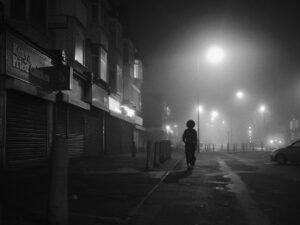“Home is a mood. It’s an atmosphere. It’s the community, it’s people… the various ingredients of your life that are important to you.” These are the words of British photographer, writer and broadcaster Johny Pitts (b. 1987), curator of After the End of History: British Working Class Photography 1989 – 2024. The exhibition, presented by Haywood Gallery Touring, brings together working class artists who use photography to explore the nuances of culture, turning their gaze towards their communities and out to the wider world. It’s a show that offers a picture of contemporary life, from Rene Matic’s portrait of growing up mixed-race in working-class Peterborough, to Elaine Constaintine’s documentation of the Northern Soul scene and JA Mortram’s documentation of marginalised people in his job as a caregiver.

Included are the careful photographs of Hannah Starkey (b. 1971), known for her cinematic mise-en-scènes, which appear as “fleeting” moments. In locations such as cafes, on public transport or on the streets, her images unfold like a dream. Starkey constructs portraits of women across a range of generations, each situated in everyday urban contexts. In Untitled, May 2022, a young woman in Northern Ireland strides down the road in pink platform boots, blue thigh-high socks and a mini skirt, heading towards a stormy blue sky. She passes a mural in Northern Ireland dedicated to the South Belfast Brigade, her red hair streaming out behind her. Starkey focuses on what it means for women to reclaim the lens. She explains, “I love it when you see a photograph of a woman or girl (female identifying), who looks like a real person who is affected by the real world without being beautiful or different or perfect.”


Also on display is the work of Nathaniel Télémaque (b. 1992), an artist born and raised in North West London. His photographs visualise the experiences of kinship as felt by Black millennials living on the White City Estate in Shepherds Bush. Figures pose on red benches and between apartment blocks. There’s a casual nonchalance to their positioning, almost as if the stills could have been taken from a Julianknxx film. Télémaque explains in an interview to Sasiety, “What was a real aim from the very beginning, was to intervene in the palpable power dynamics, whether it is the power dynamics in the city, or even the power dynamics between photographer and subject. I wanted to shift them so that there is more agency and that the subjects are more than just static.” Through his research, he unfolds the history of White City, “Prior to being a council estate, it was a world fair exhibition site. I didn’t know that. I didn’t know that every housing block and street in the area is named after colonial and imperial figures.” His practice is dedicated to uncovering colonial legacies of the Olympic site, shedding light on Britain’s “collective amnesia.”

Elsewhere, we see Kavi Pujara’s (b. 1972) ode to Leicester’s Hindu community. The artist draws from his own experience growing up in the 1970s, an experience that was particularly toughened by the rise of far-right groups such as The National Front. He was often faced with racial slurs and violence and subject to tormenting remarks. The series, entitled This Golden Mile, returns to the area Pujara grew up in. In the face of difficult memories, it pays attention to the cultural vibrancy of the area. The title refers to a stretch of road which has sari shops, Indian restaurants, jewellers – just 10 minutes from Pujara’s childhood home. He explains, “It’s about the arteries and veins that come from it, giving life to the parts of a neighbourhood away from the central commercial thoroughfare.” The photographs confront a legacy of discrimination, acknowledging how the interplay of race and wealth can perpeuate class struggles.
After the End of History is more relevant than ever. Hayward Gallery presents an exhibition that is fundamentally, unequivocally necessary, particularly in the face of current governmental policies such as the Illegal Migration Act and the Rwanda asylum plan, in addition to increased salary requirements for overseas workers. The touring show, on display in Coventry, Southend-on-Sea and finally Nottingham, tracks the recovery and regeneration of different areas across the region. It uplifts working class and Black, Brown and Asian subjects, recognising them as central to the UK’s social fabric. It’s a display that looks at what it means to remember, as it asks us to look forward, to carve out a future that demands fairness.
After the End of History: British Working Class Photography 1989 – 2024 | southbankcentre.co.uk
Herbert Art Gallery & Museum, Coventry | 29 March – 16 June 2024
Focal Point Gallery, Southend-on-Sea | 3 July – 14 September 2024
Bonington Gallery, Nottingham | 27 September – 15 December 2024
Words: Chloe Elliott
Image Credits:
1. Serena Brown, Bollo Bridge, 2018, Courtesy the artist.
2. Nathaniel Télémaque, Wavy on Ends, 2020, Courtesy the artist.
3. Hannah Starkey, Untitled May 2022, 2022,© Hannah Starkey. Courtesy Maureen Paley, London.
4. Nathaniel Télémaque, Mack Photography By Slim, 2020, Courtesy the artist.
5. Kavi Pujara, Neighbours, Dundonald Road, 2018, Courtesy the artist.





